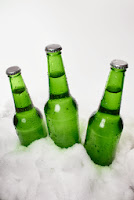You know the feeling. It’s 97 degrees outside, you just finished mowing the lawn. You’re parched and you walk inside to a commercial touting that Coors Light is the world’s coldest beer and you see that train run through the snowy Rockies. If there were any fluids still in your system, you’d salivate. Nothing is going to quench that thirst like the coldest of cold beers. And that’s fine … in that situation … and with that beer. But …
We’ve been duped. It’s no secret that the rest of the world thinks Americans drink our beer too cold, and that we view the rest of the world as behind us because they cannot develop cooling systems that can efficiently keep beer as it was intended – 32.1 degrees (or .05C). Hate to admit it, but we’re not in the right on this one. And I’m the first to admit that I am guilty of this. Also, please keep in mind that the scenario above is perfectly fine. When you’re drinking a great, plain ole American beer like a Budweiser or Michelob Ultra, you’re not harming the beer when enjoying it in icicle form. However, for most of the world of craft, specialty, yummy beers we usually feature here, frigid is NOT the goal.
Without getting into the details and science behind it, just know that the colder a beer is, the more likely it is that you’re killing the flavors inside. If you don’t want to taste the beer, serve it at 33 degrees. If you’d like to enjoy the flavor combinations, use the handy guides below to determine the perfect temperature based on what you’re having. (We at BGB do not recommend running around with a probe thermometer every time you order a beer. But it’s nice to better understand the concepts here.)
I’ll give you two sets of ideas or things to keep in mind when considering beer temperature. First is the simplest way to describe it – color usually matters. The darker the beer, the warmer it should be served. Think the super-light colored beers like American light beers – best when served as cold as possible. On the other end of the spectrum would be a rich, thick, dark Quadrupel, which should be served at something closer to 60 degrees. And there’s an important point there too. We’re not talking about room temperature beer. We are not trying to get you to let beer sit out for 6 hours to come to room temperature and get flat and gross. The warmest recommendation you will see here is about 60 degrees. Try it.
So, the second set of rules is a list of temperature by beer type. Keep this as a handy guide if you’re really that interested in it. (Or just bail out and go with the color theory.) These are general rules of thumb and we hope that you will consider enjoying a beer at its intended temperature to see what we’re talking about.
- Very Cold (32-39F). Low alcohol beers, ciders, pale lagers, malt liquor.
- Cold (39-45F). Hefeweizen, Kolsch, premium lager, pilsner, fruit-based beers, golden ale, Belgian white, dark lager
- Cool (45-54F). American Pale Ale, ambers, stout, porter, Belgian Ale, Bohemian, Dunkel, Schwarzbier (black beer), Tripel
- Cellar (54-57F). Bitters, brown ales, IPA, Dubbel, Scottish/Scotch Ale
- Warm (57-61F). Barleywine, Quadrupel, Imperial stout, double IPA, mead

